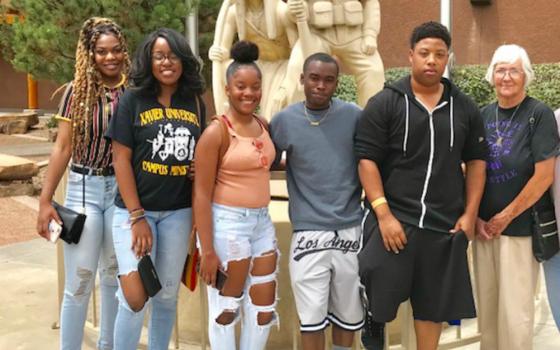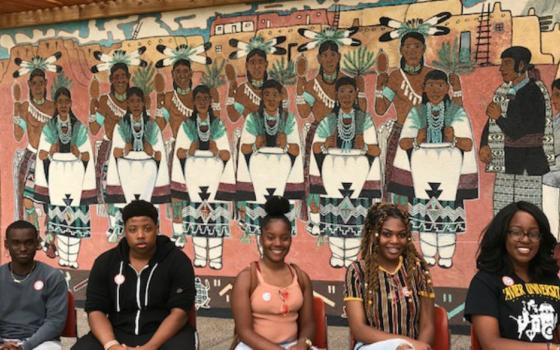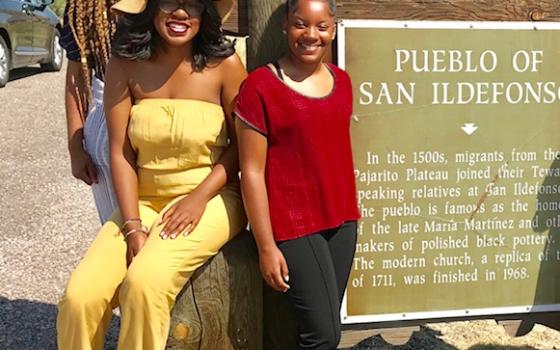Educators have moments when they stand back, observe a class event and reflect "This is education at its best." Then there are even greater moments when one reflects and observes that "something sacred is happening here."
My life as a Sister of the Blessed Sacrament converged with historical events when I created a new course at Xavier University of Louisiana. "Foundation of Native American Literature" studies literature by Native Americans, who bridge oral cultures (which preserve knowledge through rituals, ceremonies, song, chants, drumming, pottery, weaving) with cultures that understand the world through written language.
In my 10 years working and living at St. Catherine Indian School in Santa Fe, New Mexico, I shared in the Native American's way of life by being immersed in the ceremonies/rituals of the surrounding Pueblos. I have often said that my soul has taken root with the people and the land of New Mexico; however, my heart is at home at Xavier where I have worked for 30 years. Developing this course united both my passions, as two of Mother Katharine Drexel's missions met and embraced: from the university she founded to her first mission in the Southwest.
The course begins with the study of Asiatic migration across the Bering Strait into the Americas 14,500 years ago, moves to the native tribes in the U.S. today, and finally focuses on the Pueblos of the Southwest. After the classroom component, the students and I traveled to New Mexico to share an experience with the Pueblo people.
Our first visit was at Laguna Pueblo, where the Sisters of the Blessed Sacrament were hospitable and loving. The students were greeted by Sister Consolata and Sister Rosita with welcoming hugs and a snack of fruit and cinnamon rolls. Sister Consolata shared her stories about her life growing up in Laguna, her later experiences in the inner cities, and her life now that she has returned to Laguna. After she guided us around the pueblo, Sister Rosita gave us a tour of the church and told stories full of history and wisdom. We concluded our too-brief visit with a wonderful lunch feast prepared by the sisters.
On our return to Santa Fe, when we met to reflect on the day, one student summarized the experience: "When we first arrived at Laguna, I was hesitant about entering this new world. After the sisters greeted us and told us their stories, I felt right at home." Other students reflected on how they had been mesmerized by the tales, so much like the ones their grandparents told about their ancestors and their community values, or those told by their aunts and other family elders. The students all agreed that they came expecting to meet a culture unlike their own, and ended up feeling right at home.
Next we attended the feasts at the Jemez and Santo Domingo Pueblos. Sr. Patrick Marie became our Pueblo guide and mentor. Sister has been in the Southwest for over 50 years, at St. Michael's in Arizona with the Navajos, and St. Catherine's in Santa Fe with numerous tribes. She has earned love and respect as a teacher, principal, administrator and — most evident — as "their sister."
At the feast, the students observed the ancient sacred corn dances. The students were amazed as 500 members of the "pumpkin clan" danced into the plaza painted in orange-reddish clay. Immediately thereafter, another 500 dancers came into the plaza painted in blue-green clay, the turquoise clan. They observed what St. Katharine Drexel must have experienced at these dances over 125 years ago — watching these Pueblo dancers painted in blue, green, red and orange clay, it seemed as if the earth stood up to dance.
After the dances, Sr. Patrick Marie took us to visit many Pueblo homes to take part in the traditional meals offered to all visitors who came to celebrate with them. In home after home, the students observed the love and welcome that Sister Patrick Marie received as we sat down to a meal. Sister was introduced to other visitors as the principal of their school, St. Catherine's, or "this is my teacher" — and the best, "this is my sister." From great-grandparents down to young parents, all treated sister with the same love and respect that she showed them.
The Xavier students were greeted as part of their family, related through St. Katharine. At each greeting, there were questions and stories about other Sisters of the Blessed Sacrament who had made a difference in their lives. After many hours at the feasts, we were exhausted and started home, but Sister Patrick Marie stayed in the Pueblo village because she had many more families to visit. The students were astounded and inspired by her energy, dedication and love for the Pueblo people.
That evening as we met to reflect on the day, the students spoke of being deeply touched by the dances and grateful for our guide and mentor. They agreed that Sr. Patrick Marie — watching the dances, standing silently and reverently for a long period of time in the unrelenting sun — seemed to be part of the ceremony.
After visits to other pueblos and a tour of the ancestral pueblo dwellings at Bandelier National Monument, our closing experience was at the Pueblo Cultural Center in Albuquerque, owned by the 19 Pueblos of New Mexico. One major exhibit featured the life and legacy of Bob Chavez, a famous artist from the Pueblo of Cochiti. He dedicated his life to St. Catherine's Indian School after a promise to God on his safe return from the WWII Bataan Death March. Sister Consolata was instrumental in creating and developing this exhibit. The students were proud to see to see St. Katharine Drexel highlighted in this section of the museum, and they felt their own connection with the Pueblos. (In fact her image is displayed in many places in Santa Fe and in Pueblo homes.)
As I reflect on this experience, I recall the many Pueblo tables around which the students shared a meal and engaged in deep conversations, and I know that this was more than an educational experience: This was a celebration of Eucharist.
I am sure Mother Katharine is smiling in love at her Sisters of the Blessed Sacrament who followed her and created the pathway from the Pueblos of New Mexico to Xavier University of Louisiana — and at the alumni, students, and the generations of Pueblo peoples who still speak her name with respect and honor her passion for justice. Yes indeed, something sacred is happening here.
[Donna Gould is a Sister of the Blessed Sacrament from Los Angeles, California. She spent many years ministering in the Southwest among the Pueblo and Navajo peoples. Her doctoral studies are in American literature, folklore and cultural studies, and she is currently an associate professor of English at the Xavier University of Louisiana.]



